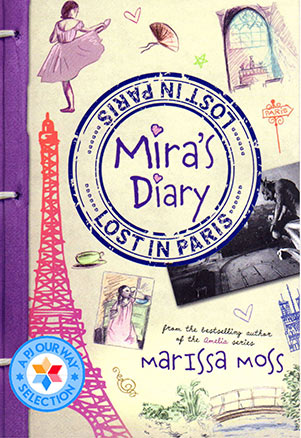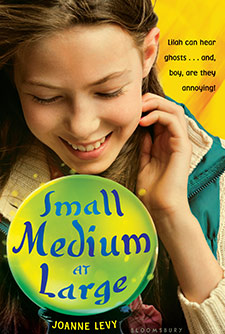Mira’s Diary: Lost in Paris
Mira’s mother has been missing for months. Then, her family gets a postcard with a clue: a picture of the Notre Dame Cathedral in Paris. Now Mira’s trapped in the past! Will she – and her mom – ever find their way back home?
Average Rating
( hint: Login to leave a review! )
183 Reviews
Leave Review
What the Book is About
Jewish Content & Values
Positive Role Models
Content Advisory
Talk it Over!
More for You
What the Book is About
Mira is about to start junior high school, but there’s one big problem: her mother has been missing for months! Mira’s father has complete faith that she will return soon, but when he receives a mysterious postcard from Paris, he decides to travel there with Mira and her older brother, Malcolm, to search for clues. During their visit to the Notre Dame Cathedral, a creepy stone gargoyle catapults Mira into the past and we learn that she has inherited her mother’s gift for time travel. Now in Paris in 1881, Mira catches glimpses of her lost mother and meets famous nineteenth-century French artists like Degas, Mary Cassatt, and Renoir. She becomes involved in the trial of Alfred Dreyfus, tries to fight anti-Semitism, and inspires the famous writer Émile Zola to write his J’Accuse article in support of Dreyfus. Written from Mira’s point of view and illustrated by Mira’s little pencil drawings, this fun time-travel diary is sure to please.
Jewish Content & Values
- While in Paris, Mira and her family stay in a hotel in the Jewish Ghetto and Mira travels back in time to witness a virulently anti-Semitic mob who come to watch the demotion of Alfred Dreyfus, a Jewish French artillery officer. A well-researched Author’s Note at the conclusion of the book offers more details about the infamous Dreyfus Affair and this fascinating historical period.
Positive Role Models
- Mira is a plucky character who is deeply dismayed by intolerance and the ugly displays of anti-Semitism that she encounters. She tries her best to help Dreyfus and to look after her mother.
- Émile Zola was an admirable human being, risking everything to support the cause of truth. After he wrote J’Accuse, he was sued for libel and was financially ruined; he was even forced to leave France. It is suspected that he was murdered for speaking out against military corruption.
Content Advisory
Some kids might be disturbed by the fact that Mira’s mother has been missing for several months and then refuses to acknowledge Mira when they finally do meet in the past. Some readers could also be offended when Mira, a Jewish girl, lights a candle at the Notre Dame Cathedral and prays for her mother’s safe return home. There are some blatant displays of vicious anti-Semitism, and Mira and Claude (Degas' apprentice) share a few light romantic moments.
Talk it Over!
- Mira really likes Degas and she falls in love with his lifelike sculpture of the ballet dancer. But then she hears him saying terrible things against Jewish people. How do you think this changed their friendship? Do you think it also changed how Mira felt about Degas' art?
More for You
Camille Pissarro, a Jewish-Danish-French Impressionist master, lived in France in the nineteenth century. His paintings often featured outdoor scenes in natural light, and Émile Zola, was a great fan of his work. Although few of Pissaro’s paintings sold during his lifetime, today his art is worth millions.
What the Book is About
What the Book is About
Mira is about to start junior high school, but there’s one big problem: her mother has been missing for months! Mira’s father has complete faith that she will return soon, but when he receives a mysterious postcard from Paris, he decides to travel there with Mira and her older brother, Malcolm, to search for clues. During their visit to the Notre Dame Cathedral, a creepy stone gargoyle catapults Mira into the past and we learn that she has inherited her mother’s gift for time travel. Now in Paris in 1881, Mira catches glimpses of her lost mother and meets famous nineteenth-century French artists like Degas, Mary Cassatt, and Renoir. She becomes involved in the trial of Alfred Dreyfus, tries to fight anti-Semitism, and inspires the famous writer Émile Zola to write his J’Accuse article in support of Dreyfus. Written from Mira’s point of view and illustrated by Mira’s little pencil drawings, this fun time-travel diary is sure to please.
Jewish Content & Values
Jewish Content & Values
- While in Paris, Mira and her family stay in a hotel in the Jewish Ghetto and Mira travels back in time to witness a virulently anti-Semitic mob who come to watch the demotion of Alfred Dreyfus, a Jewish French artillery officer. A well-researched Author’s Note at the conclusion of the book offers more details about the infamous Dreyfus Affair and this fascinating historical period.
Positive Role Models
Positive Role Models
- Mira is a plucky character who is deeply dismayed by intolerance and the ugly displays of anti-Semitism that she encounters. She tries her best to help Dreyfus and to look after her mother.
- Émile Zola was an admirable human being, risking everything to support the cause of truth. After he wrote J’Accuse, he was sued for libel and was financially ruined; he was even forced to leave France. It is suspected that he was murdered for speaking out against military corruption.
Content Advisory
Content Advisory
Some kids might be disturbed by the fact that Mira’s mother has been missing for several months and then refuses to acknowledge Mira when they finally do meet in the past. Some readers could also be offended when Mira, a Jewish girl, lights a candle at the Notre Dame Cathedral and prays for her mother’s safe return home. There are some blatant displays of vicious anti-Semitism, and Mira and Claude (Degas' apprentice) share a few light romantic moments.
Talk it Over!
Talk it Over!
- Mira really likes Degas and she falls in love with his lifelike sculpture of the ballet dancer. But then she hears him saying terrible things against Jewish people. How do you think this changed their friendship? Do you think it also changed how Mira felt about Degas' art?
More for You
More for You
Camille Pissarro, a Jewish-Danish-French Impressionist master, lived in France in the nineteenth century. His paintings often featured outdoor scenes in natural light, and Émile Zola, was a great fan of his work. Although few of Pissaro’s paintings sold during his lifetime, today his art is worth millions.



